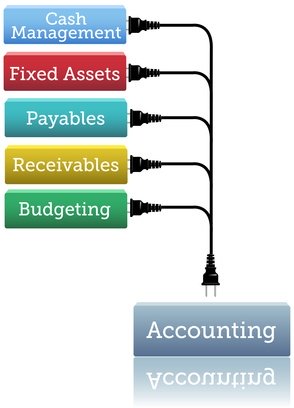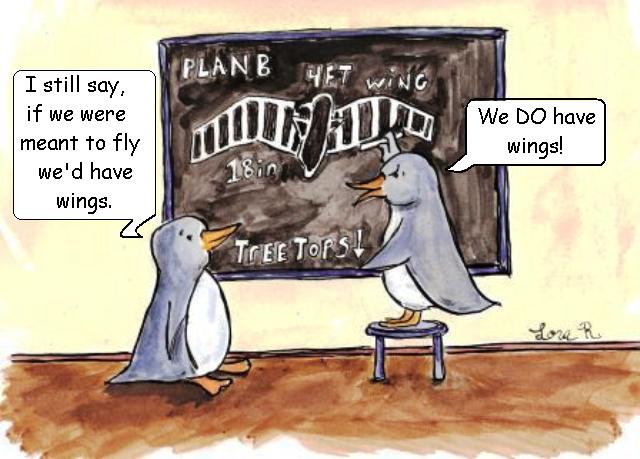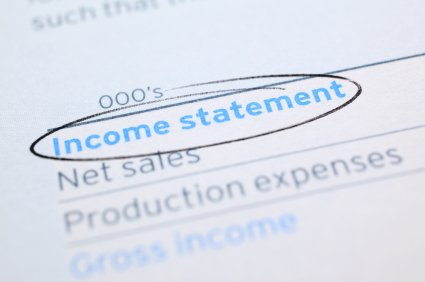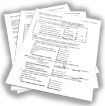- Home
- Basic Bookkeeping Practices
- Profit First Method
Profit First Method*: A Behavioural Cash Management System
Make Your Profit Deliberate and Intentional | Focus On Cash Flow

by L. Kenway BComm CPB Retired
This is the year you get all your ducks in a row!
Published October 3, 2025 | Updated October 4, 2025 | Edited November 17, 2025
WHAT'S IN THIS ARTICLE
What is it? | How does it work? 4 steps | How to self-diagnose your business health | Establishing rhythm and evaluating expenses | How to do it? 5 steps | Not every business fits into the box | Accountability and consistency | Wrap-up
NEXT ARTICLE >> How to Get Out of Business and Personal Debt
📊 Key Takeaways: Make Profit Intentional
What is Profit First? A cash management system that flips the traditional formula to: Sales - Profit = Expenses
The 4-Step Method:
- Multiple bank accounts - Divide incoming cash into 4 "plates": Profit, Owner's Pay, Tax, Operating Expenses
- Pay yourself first - Take profit and owner's pay BEFORE paying expenses
- Remove temptation - Move profit and tax accounts to a separate bank
- Create rhythm - Allocate funds twice monthly (10th and 25th)
Why it works: You'll intimately know your cash flow patterns and spot problems before they become crises.
Time investment: Initial assessment takes 2-3 hours; ongoing rhythm takes 30 minutes twice monthly
Bottom line: Stop being a martyr in your business. Too many solopreneurs embrace what Mike Michalowicz calls "entrepreneurial poverty" ... working harder while paying themselves last (or not at all). This system flips that script. It ensures you get paid first AND build business reserves while keeping expenses in check. It shows you the steps to take so your business can support you AND the lifestyle you're working so hard to build.

I've always been interested in how to manage cash. A few years ago, with inflation and high interest rates squeezing businesses, knowing how to manage your cash flow became critical just to survive. Now? The landscape has shifted again. If you've been reading the news lately (whether it's Reuters, the Financial Post, Statistics Canada, the CBC, or the BBC) you've seen the headlines: inflation is ticking back up in both the U.S. and Canada, supply chains are being disrupted by new tariffs and trade tensions, and yet interest rates are finally coming down.
This past week, Canada-U.S. Trade Minister Dominic LeBlanc told the Senate Committee on Foreign Affairs and International Trade: "The relationship with the United States has fundamentally changed and it will not magically go back to what it may have been a year ago or 25 years ago." That combination of rising costs, falling rates, and deep uncertainty can tempt business owners into a debt-fuelled spending spree. Don't. You can choose to be intentional about managing your cash flow and growing your profits instead. I'm going to chat about one way to do that.
I just watched a great series of free webinars at the Universal Accounting School with guest speaker Erin Moger from Profit First Professionals. The series walked you through how the Profit First method works and how you can get started implementing it.
Here are my notes from watching the series. I've added links to the free videos at the end of this chat. I applied a variation of this system to my own business (well before I retired) and it works. It was so nice not having to check bank balances and know not only was there enough to cover bills but also after about a year using the system, there was a cash reserve for the unexpected expenditures. This system is worth implementing in your work from home business.
In the first webinar, I particularly enjoyed how Erin (1) made an analogy of good nutritional habits (something everyone can relate to) to managing the cash in your business so you harness your natural instincts to managing your money; (2) provided a structure to analyze the health of your own business; and (3) discussed how to establish a rhythm to your cash flow and steps to take when you experience a cash crunch.
What is the Profit First Method?
- What is Profit First? Sales - Profit = Expenses is a behavioral cash management system making profit deliberate and intentional; introduced in the book Profit First by Mike Michalowicz.
- What are Profit First Core Principles? Its principles are establishing financially fit habits for a healthy business. It helps you get and keep all your ducks in a row.
- How does it achieve this? The Profit First method shows you how to prioritize and make better decisions in your business. It has four steps:
- A Serving Tray and Small plates
- Veggies first
- Remove temptation
- Establish rhythm
Let's dive deeper.
How Profit First Method Works
Erin introduced Profit First's method to eradicate entrepreneurial poverty. It all begins by making a small twist to a centuries old accounting formula.
She explained why their system came up with Sales - Profit = Expenses. It was to create an automatic alarm system in your business.
The method works as follows:
Step One: A Serving Tray and Smaller Plates
It starts with looking at all the cash coming into your business as one large serving tray. The system plates the food (serves the cash) out from the serving tray to four small (not large) dinner plates. The serving tray and dinner plates are bank accounts. The strategic bank accounts are:
- Serving tray: all cash coming into the business
- Small dinner plate one: profit = freedom and lifestyle experiences
- Small dinner plate two: owner's pay = the business supporting you
- Small dinner plate three: tax = withholdings so the business continues supporting you
- Small dinner plate four: operating expenses = being intentional about where and when you spend.
Step Two: Veggies First
DO NOT BE A MARTYR. Get your nutritional sustenance by eating your veggies first (not your meat and potatoes). The veggies represent your profit. You take ... PROFIT FIRST ... then your Owner's Pay. Think of Owner's Pay like a pay cheque where taxes are withheld so you are able to pay your tax when you file your income tax return. For clarity ... take out your NET pay not your GROSS pay so you don't run into trouble at tax time.
The 'Profit' account provides you the lifestyle experience as owner of the business. You didn't go into business to just collect a pay cheque like an employee. However the lifestyle experience won't happen unless you plan for it to happen.
Step Three: Remove Temptation
Remove the temptation to cheat or sneak extra calories by moving your Profit dinner plate and Tax dinner plate to the freezer (another bank). You know the saying ... out of sight, out of mind. Tap these accounts for quarterly distributions and enjoy the reward of your hard work, your intentionality. You get to have a lifestyle experience because you are the owner.
Step Four: Frequency - 10/25 Rhythm
Establish a deliberate routine so it becomes a habit. Plate the food twice a month - on the 10th and 25th. Watching your cash "wave" build and release creates an automatic alarm system. It lets you investigate and address problems before they become permanent. You begin to intimately know your cash cycle so when something is off ... you just know something is OFF.
As you watch the cash build you'll notice if it is out of whack or less than you were expecting:
- Is it because you forgot to invoice some customers? Get those invoices out now, today!
- Or did some of your fixed costs increase due to price increases by your suppliers? Call them up and see if you can negotiate a better price!
- Or is it something else? Dig around and find out now before you experience cash flow issues.
The Profit First method uses bank accounts to facilitate clarity. You learn the rhythm of how your cash flows ... money in ... money out. You'll know when there is a problem.
Profit First Method
How To Self Diagnose Your Business Health
Let's dive deeper because the best learning is done by doing. Erin demonstrated in the second webinar how to do an evaluation of the health of your business yourself. She shows you what the Profit First system would look like for your business.
Let's walk through the steps Erin laid out in the webinar. She will be referencing the Profit First Instant Assessment Form. You can get your copy on Mike's free resources page. It's worth downloading the PDF.
1. Let's talk CASH. Don't fall for the survival trap. Recognize spending is emotional.
1. Let's talk CASH. Don't fall for the survival trap. Recognize spending is emotional.
How much money did you actually make last year?
Profit First is not a guessing game. There's a lot that happens outside of your P&L (Profit and Loss Statement) number and that's why you can experience a cash crunch.
How healthy is your business really?
Your P&L says you have a profit but you're confused because:
- You don't have enough money to pay your payroll or your taxes.
- You are not paying yourself regularly.
- You are maxing out your credit lines regularly.
- You have no idea how you are going to pay for your job coming up because you haven't paid off your last job.
If you don't have the cash on hand, profit doesn't count. Cash is king. As a business owner, you need to heed advice to maximize your profit and not pay unnecessary taxes.
Key Takeaway
You can be intentional on diagnosing how healthy your business really is. Keep reading to learn the method used by Erin to illustrate how to run a Profit First Instant Assessment on your business. It is a very basic level 1 baseline breakdown on what is happening with your business under the surface.
2. Run Your Profit and Loss Statement With a Percent of Revenue Column.
2. Run Your Profit and Loss Statement With a Percent of Revenue Column.
To start your Profit First Instant Assessment on your business you need to have on hand your Profit and Loss Statement (P&L), Balance Sheet (BS) and personal tax info from your last three fiscal years.
As Profit First is a cash management system, you need to run your P&L on a full year cash basis (not accrual). Cash basis is more simplistic than accrual basis. This is easily done if you use an accounting software platform such as QBO (QuickBooks Online). Adding a '% of Revenue' column will help you through this exercise. Don't forget to save your custom report for future reviews.
GAAP basis statements (accrual based) may be part of the reason why you experience cash crushes because profit is not cash. It was never intended to be used to manage your cash.
More >> Where did all my cash go?
More >> Profit is not cashflow!
3. Determine your targeted allocation percentages (TAP).
3. Determine your targeted allocation percentages (TAP).
See slides in the second webinar for how to fill out the TAP assessment worksheet; or download the worksheet on Mike's free resources webpage. Take lots of notes as you go and write down your questions to get the most out of the instant assessment.
1. Start by Calculating Your Real Revenue
Real revenue is different than gross profit. GAAP emphasizes a comprehensive inclusion of direct costs for financial reporting accuracy, whereas Profit First isolates costs that flow directly through, to highlight operational funds genuinely available. This helps business owners clearly see how much money can actually be used for sustaining and growing the business, stripped from costs that don't contribute to profit retention.
Profit First:
Real Revenue = Total Revenue (Gross Income) - Pass Through Costs
Total revenue is money flowing into your business regardless of source.
Pass through costs are materials (directly tied to producing a product or service) and subcontractors costs. Pass-through costs are the direct costs that are not retained by the business to contribute to profits. Erin says it is usually 25% of revenue or possibly greater.
Materials exclude direct labor costs and production overhead as they must be paid whether your sales personnel have good or bad sales days. Write your real revenue calculated on the assessment form.
GAAP:
Gross Profit (or Gross Margin) = Total Revenue - Cost of Good Sold (COGS).
COGS = Direct Labor - Production Overhead - Materials (directly tied to producing a product or service) - Subcontractor Fees - Third-Party Reselling Payments. COGS is also known as direct costs.
Example of Real Revenue Calculation:
Let's assume for this example:
- Total Income: $200,000
- Direct Labor Costs: $25,000
- Production Overhead Costs: $15,000
- Materials and Supplies*: $30,000
- Subcontractor fees*: $20,000
- Third Party Reselling Payments*: $10,000
- *Total Pass Through Costs: $60,000
Real Revenue Calculation:
Real Revenue = Total Income - Pass Through Costs
$140,000 = $200,000 - $60,000
COGS Calculation:
COGS = Total Income - All Costs Directly Related to Production
$105,000 = $200,000 - $50,000 - $25,000 - $15,000
By excluding direct labor and production overhead costs from the gross margin, Profit First realigns focus toward money that can contribute to profit generation. Unlike conventional methods, this allows business owners to craft a direct look at their operational efficiency and cash available to support profitability, investment, and owner’s compensation without muddling clarity with costs considered necessary but not influencing direct profit margin.
Key Takeaway
While the business in this example has $200,000 in sales, for profit allocation purposes, it is really operating as a $140,000 company; profit money in the bank is set aside intentionally as profit or for an emergency. This is what is defined as real profit; what you have to make the company grow and to treat yourself as an owner. Erin says that if you don't have 2-3% set aside in your profit account you own a job.
Tip
Service based businesses likely don't have materials & inventory but may have subcontractors. How significant is this piece of your business? If you don't have subcontractors, put a 'not applicable' on the assessment form.
2. Profit Account Benefits The Owner
The Profit Account benefits you by giving you the emotional freedom to take money from the business with confidence. This can be impactful because you know your business can afford to support you or the business itself in the event of an emergency.
Write your profit number on the form. This is money you have in the bank or have distributed to yourself as a bonus. It should exclude your salary. It is possible this number in your business is currently at zero.
3. Paying Yourself With Structure and a Bit of Intention
Many small business owners will say they haven't ever paid themselves since starting their business or do not regularly pay themselves. However this isn't always an accurate statement. Erin explains the owner likely runs personal expenses (an informal method of owner pay) through the business in one manner or another in cases such as this.
The Profit First method forces you to pay yourself with structure and intention. You clearly define your standard of living so you can see how the business is supporting you. This allows you to reconcile your perception versus the reality.
- Owner's pay account includes compensation received through salary, draws, distributions, personal transactions through the business, and your personal car. This calculation excludes bonus as we included that number in the profit account.
- Tax account includes funds set aside for personal and business income taxes, which are forms of compensation in a nontraditional sense. This number does not include payroll tax or sales tax.
To calculate this figure, include your personal and business taxes you paid last year plus any funds you reserved for this year's tax payment. - These two accounts together create balance and ensures the business is taking care of you. Write your numbers for these accounts on the assessment form.
4. Regular Cash Responsibilities
Your operating expenses are your regular cash responsibilities. Write down last year's operating expenses on the assessment form. Be careful to not double count expenses already plated on the other 'dinner plate' accounts such as your salary as we've accounted for that in owner's pay). Do include debt repayment (which happens on balance sheet not income statement).
5. Proof Your Calculations
The dinner plates should total to your Real Revenue amount. If they don't, you've made an error in your calculations. Go through your numbers and find your error.
Key Takeaway
You are not trying to make this assessment look pretty. You are trying to establish where your business's current rhythm is at now. You may have negative numbers in the bleed column. Don't beat yourself up. For the system to work and help you fix your issues, you need to:
- Be true.
- Be honest.
- Ask questions.
Erin (as well as Mike's book and assessment PDF) provides you with industry averages slotted into the assessment form. The averages are broken down by real revenue ranges. You initially want to aim for the average in your range; then you want to surpass the average. Erin reminds you that you did not go into business to be average. You went into business to excel.
Use the Profit First Structure
Use the Profit First structure to position your business. Use the structure to inform you about where your business is relative to other businesses of your revenue size and use it to bring clarity of your day to day operations.
Let's assume because you are on this website, that your real revenue range is between $0 to $250,000. Profit First industry averages for that real revenue range are 5% profit, 50% owner's pay, 15% tax, and 30% operating expenses = 100% real revenue
Calculate your percentages and see how your business compares. You might not fit in this box. You might want to pay yourself more and spend less on operating expenses. This is where you define what success is for you and what you want to achieve.
Identify a strategy or prescription to achieve your optimal health
Identify a strategy or prescription to achieve optimal health for your business. Use the system to empower you to be vigilant within. The system gives you the freedom to identify what success is to you or what you want achieve. Acknowledge that it's going to be difficult to achieve it.
You might not ever achieve your target but you are going to strive to work toward it. How can you capitalize on every resource you have? Use your target to drive you to be more innovative and put you in a place to ask deeper questions to meet or exceed industry standards.
Compare your numbers to the TAP (targeted allocation percentages) to see where you are. Now you have something to work towards and challenge yourself to do better.
How can we make the business support this?
The answer might be in sales, operating expenses, or systems and processes. Explore all the avenues to achieve this in the most healthy way possible.
Stay Vigilant! Evaluate quarterly & adjust. But get started. If you know you have 76% for operating expenses put 70% in your operating expenses account. Generate an action plan and evaluate every quarter.
Many business owners love a challenge. Here is a system that can make their business better. This shows you how to put profit first.
Erin is passionate on this topic. She reminds you there is freedom in knowing your business can support you and confidence that you can cash your pay cheque.
Profit First Method
Establishing Rhythm and Evaluating Expenses
Earlier, step 4 of the Profit First Method was establishing a 10/25 rhythm. Now that you have TAP calculated, let's look at how to establish this rhythm.
If examining your business like this is uncomfortable, it's okay. If you get emotional. That's okay. You may feel vulnerable. Erin reminds you to keep moving to learn how you can improve your business to support the lifestyle you want.
Remember, having a positive net income doesn't mean your business is healthy. Erin walks through the steps along with commentary from Angie Burns who implemented the Profit First method on her two businesses.
Erin points out that the Profit First Method is like guests coming in the back door of your home instead of the front door.
Profit First Method
Don't Fall For The Survival Trap
On page 20 (might a different page in your book) of Mike Michalowicz's Profit First book, you will find a diagram of The Survival Trap. It's worth looking at.
Don't fall for the survival trap. Mike Michalowicz explains this concept on page 37 of his Profit First book. The survival trap promises fast wealth but requires debt-generating income instead of profit first income. The survival trap is all about acting to get you out of crisis instead of driving you towards your vision. The survival trap takes you in the opposite direction of your vision.
When you have a cash crunch, your first thought is to increase sales, your product offerings, or increase revenue through price increases but the problem is this doesn't address the issues. It will not solve the struggle you are experiencing in your targeted allocation percentages (TAPs).
How do you get to your target percentages?
Step One: Cost Cutting
What changes the struggle is committing to not entering the survival trap. What changes the struggle is looking at how you spend, your systems and processes, and your mindset. In most instances, if there is trouble in the business, something is going on under the surface that's causing it.
Erin says, the first step to solving it is starting right in our minds. Taking an expense evaluation, looking at your numbers, digging deeper ... that's no exception. It is just as much a physiological experience as everything else.
Recognize Spending Is Emotional
Spending is emotional and tied to dopamine. We are wired for that temptation. So stopping it is difficult. It's difficult to eliminate waste and uncover your profit potential. It's difficult to identify what is excess. We would much rather not lose something than gain something of equal value. This is called loss aversion. It's more exciting to not lose $5 than it is to find $5.
Let's get started. You need to run your Profit and Loss Statement for the last three years. Each year should include should include a % of revenue column. This is done in QBO by customizing your report to add the column.
Step Two: Determine Your Tap
For this example, if your business has real revenue between $0 and $250,000, then you are aiming for 5% profit, 50% owner's pay, 15% tax, and 30% operating expenses.
Step Three: Reverse Engineer
The Profit First method is going to work in conjunction with your natural behaviour. Erin showed how to reverse engineer into your TAP target.
So far you have your target percentages and you have your actual percentages. Looking at your P&L, what in here is imperative to my business? What do I need to genuinely survive? We are not looking at identifying any excesses (which is really hard to do) just identifying what are your business's needs. Look at your software expenses, rent, electricity, payroll. What is imperative to functioning? Once you see you that you've got 30% in that sum, then we are going to ask ourselves a couple of questions.
Step 4: (W)ring The Towel
You've now completed the instant assessment on your business. Now you ask more questions. Here's where you generate a roll out plan to achieve these gradually. This is where the fun is! Most entrepreneurs are creative people. So yes, when you start tweaking for what's next?, it's fun for most entrepreneurs.
This is where the main chunk of this exercise comes into play. Take a look to see where you can cut expenses. Erin calls this (w)ringing the towel.
- Expense is essential.
- Expense is I can negotiate or find another vendor.
- Expense can be eliminated for the short term.
- Expense can be cut all together.
Ask yourself ... how can I make the business support this?
When looking at your expenses, dig deeper on every line. Come up with a ranking system. Ranking your operating expenses makes it easier to sort through your monthly expenses.
Here's where Erin introduced the concept of wringing the towel by doing the following:
- Call and negotiate! Learn the power conversation around what can you do for me? They might not cut your expenses, but they might give you a greater value for what you have to pay already. You might get the new technology coming out for no extra cost at all that increases your efficiency.
- Explore other options. Is it as relevant as it could be? You could be spending a boatload of money that is irrelevant now because things are constantly changing and evolving. What are the best options out there. You may find one that increases your efficiencies at a cheaper rate.
- Confirm there is no overlay. This is really easy to do. For example, you may have Dext and Hubdoc. Do you need both of them? Can you consolidate them in a way that makes them more efficient and effective? Is there a way to cut your transactional relationships down by creating your own technology stack?
- Create systems to track and identify your daily investments. These are the things that are impactful and imperative to the functioning of your business.
In this level 1 dive, you might not be able to walk back much of the 30%. You may only find half a percent or less. Erin says, kudos to you. You've cut half a percent on something that is imperative to your business. You've confirmed your businesses efficiencies. You've ensured your technology is positioned to be the strongest it can be. That is a very powerful thing.
If you aren't doing this assessment, it won't be done. You can't delegate this task. Let me repeat that. If you aren't doing this assessment, it won't be done.
Step 5: Where do you stand?
Now you have to ask the question ... is the business able to function on this 30%. The things that you have that complete the 30% bracket, is your business still able to function?
- If the answer is yes, eliminate the outlying expenses then maintain. Go for it. Try it!
- If the answer is no, add 10% to the target and repeat steps 4 & 5. If you still can't function, add another 10% and repeat the exercise.
This exercise removes some of the emotion from cutting expenses because you are comparing all expenses to what is imperative for your business. Everything you spend on is taking away from something else you could be doing with your money.
Every time you spend a dollar think about it. It could be the difference between having a candy bar in your hand now or having a comfortable retirement. Go back to why and the reason you are driven to have a successful business. It brings perspective to the table.
What about those extreme situations? Not every business fits into a box.
How do you handle an industry like IT or the medical industry in relation to excess and payroll? How do you handle that in an expense analysis? Angie explained how she did it with her businesses:
- Parse out the payroll to determine what does it actually cost to run the business. Income generating higher paying positions should cover their own payroll expenses plus a portion of the overhead expenses including covering the admin positions and finance that isn't in a revenue generating position.
- Have a separate bank account for payroll and allocate to it on a weekly basis so you know you can meet payroll. Carving out payroll to a separate account gives you the freedom to know which bills you can pay and which you can't. It sheds so much light on your overhead costs. No more guessing.
- When hiring a revenue generating position, ask where is my greater need and what do I need to achieve to sustain my business. Angie gave the example of hiring another doctor versus hiring a physician's assistant; or hiring a programmer versus a level 2 or 3 tech versus a help desk employee. Asking this question so you can fit within your parameters helps you from overspending. What does your business need to service your clients. Same thing with accounting. Do you need a CPA on payroll or can you train someone to do bookkeeping? Asking these questions helps you stay within your parameters and know how much you can offer an employee coming in.
- Special insurance requirements may also be a unique expense to a particular industry.
- In the back office focus on efficiencies. The more efficient the back office is, the more profitable the business is.
- In the front office, focus on client acquisition and client retention to generate sustainable revenue.
Key Takeaway
Profit First percentages are what drive the program. Industry averages are a good benchmark but don't make the benchmark your goal. It is just an average. Try to achieve the target percentages you set for your business. We can all be better.
Stay Vigilant! Accountability and Consistency Change the Game.
Stay vigilant! Accountability and consistency change the game. There is power in taking action.
Develop a rhythm.
Do a review every quarter. Look at dues and subscriptions at every review; they don't just become recurring overnight! There is a lot of good that come from being proactive instead of reactive. After you've done the evaluation, apply what you've learned so you can move the needle.
Angie said she found that by going through the analysis, she started to look at things differently. You'll start to step back and really reassess. Before spending money, you'll find yourself asking, is this really going to help me get to my targets?
Every small step is a step in the right direction.
It is looking at how you spend, your systems and processes, and your mindset. In most instances, if there is trouble in the business, something is going on under the surface that's causing it. Erin says, the first step to solving it is starting right in our minds. Taking an expense evaluation, looking at your numbers, digging deeper ... that's no exception. It is just a much a physiological experience as everything else.
Wrap-Up
Businesses can be like spoiled children always having temper tantrums until they get what they want. It is up to you (the parent) to know what is best for your "child" to meets their needs and not spoil them to your detriment.
You can learn more about Profit First by purchasing the book on Amazon. There are also spin off books available from business owners who show you how they have implemented the system successfully in their businesses.
You can also watch Universal Accounting's videos for free here:
- How to establish a profitable business from day one
- How Healthy is Your Business?
- Establishing Rhythm and Evaluating Expenses
It really is an enjoyable series to watch and learn. Erin Moger has a natural way of speaking and teaching that leaves you wanting ... more.

It's been great chatting with you.
Your Tutor
* Profit First is a registered trademark in the U.S. and other countries.
Disclaimer: I am not a certified Profit First Professional or associated with Mike Michalowich. I just like the system and introduced some of my client's to it. Get Mike's book to learn more about the system.
Learning How To Read Your Internal Financial Reports
Tools for the Home Based Business Owner
 How Your Financial Plan Is A Road Map
How Your Financial Plan Is A Road Map Why You Want The New NTR Report
Why You Want The New NTR Report



